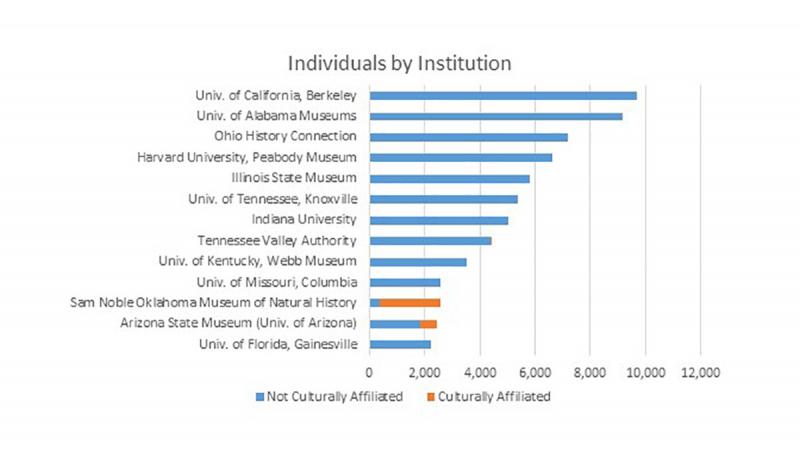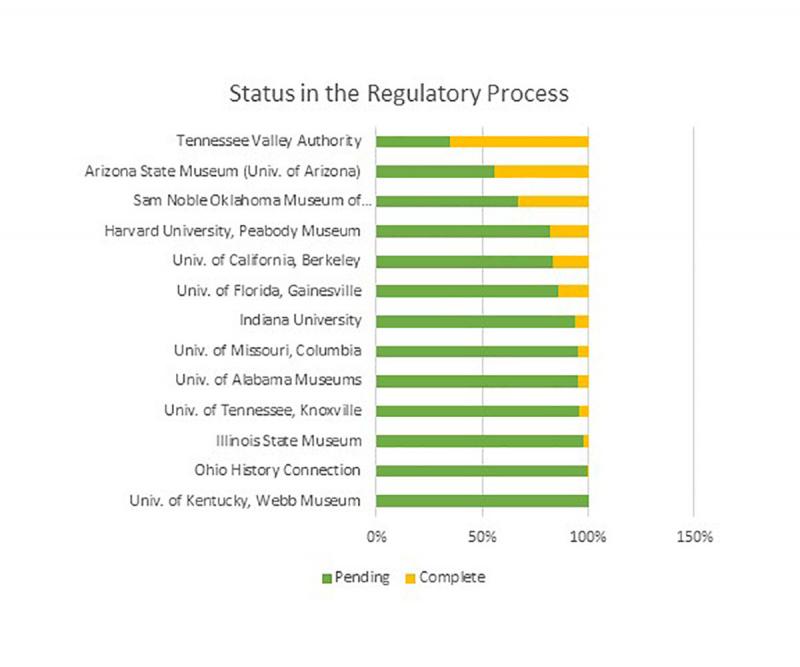NAGPRA Data
During the July 24 NAGPRA Community of Practice call, Melanie O’Brien from the National NAGPRA Program shared new tools for locating NAGPRA collections. One of the tools was a website featuring visualizations of NAGPRA data (as of September 2019).
Based on that data, we now know that 56% of the Native Ancestors listed in NAGPRA Inventories but not yet published in a Notice of Inventory Completion are held by only 13 institutions. Each of these 13 institutions holds over 2000 Native Ancestors (Figure 1). This concentration of so many with so few raised a few questions for me.

Figure 1. Native Ancestors held by Institutions (not yet Published in Notices), as of September 2019.
Questions
The first question that came to mind was:
How accessible is the contact information for a NAGPRA representative on each of the institution’s websites?
Using Google and exploring each institution’s website, I was able to easily find contact information for seven out of the 13 institutions. For the remaining five, I could not identify the NAGPRA contact. One institution’s repatriation webpage had text encouraging consultation but no contact information for initiating consultation.
I also wondered what the total number of individuals reported for each institution was and what percentage of the total had been published in a Notice of Inventory Completion.
I was able to use these data visualizations to answer that question.
I found out that Tennessee Valley Authority has reported a total of 12,566 individuals with 4,381 remaining in the collection, meaning they have published a Notice for 65% of their inventory. On the other hand, the University of Kentucky, Webb Museum has never published a Notice of Inventory Completion.

Figure 2. Institutions’ Status in the NAGPRA Regulatory Process: Percentage of Pending (Native Ancestors without published Notices) and Percent Complete, as of September 2019.
Some other questions that came to mind:
How many staff are responsible for NAGPRA implementation at these institutions?
Are the institutions aware of their position in relation to other institutions? Do they have an action plan to increase their percentage of complete? How long do they anticipate it will take to consult and publish Notices for these collections?
Could this list help practitioners advocate internally for increased resources (i.e. staff and budget)?
How many NAGPRA consultations do these institutions participate in each year?
How many NAGPRA Notices do these institutions publish each year?
For institutions with culturally affiliated Native Ancestors, what needs to happen to proceed to Notice publication?
For institutions with Native Ancestors that are not culturally affiliated, does the museum have a plan for implementing 43 CFR 10.11? Should institutions initiate consultation upon request or proactively?
What questions come to mind for you?
Limitations
I want to take a moment to recognize the limitations of this data. Anecdotally, we know there are Native Ancestors held by institutions and agencies that have not been reported in NAGPRA inventories at all. Those individuals are missing from these totals.
It is also possible that there are some errors in the dataset. The National NAGPRA office is working on resolving any known errors, and asks that you contact them if you notice any potential errors with your own institutional data.


